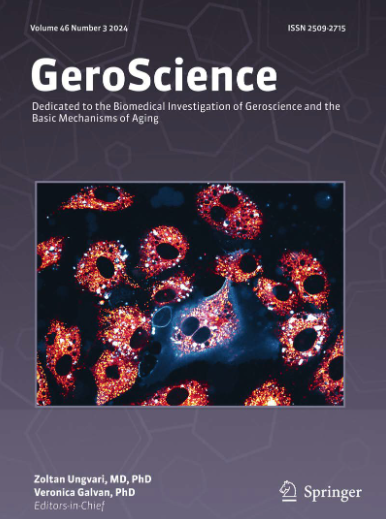Estimation of biological age and age-related outcomes with easily accessible parameters in Chinese.
IF 5.4
2区 医学
Q1 GERIATRICS & GERONTOLOGY
引用次数: 0
Abstract
Biological aging exhibits significant heterogeneity across individuals, and a precise evaluation at scale is urgently needed. Here, we developed a PCAge, based on common clinical, physiological, and laboratory indices routinely collected in primary healthcare, in the CHARLS. PCAge demonstrated strong correlations with chronological age (r = 0.86-0.88, P < 0.001) and robust performance in the prediction of mortality (C-index = 0.798) over a 10-year follow-up. Biologically older individuals (PCAge > chronological age) suffered from substantially higher risk of age-related diseases, including cardiovascular disease (HR = 1.30, P < 0.001), heart disease (HR = 1.35, P = 0.003), stroke (HR = 2.38, P < 0.001), hypertension (HR = 1.28, P = 0.007), and diabetes (HR = 1.51, P < 0.001). Furthermore, the generalizability of PCAge was validated in the South China Cohort (SCC, n = 68,920). Biologically older individuals were more likely to have hypertension, diabetes, cardiovascular disease, and respiratory diseases. Being female (proportion ratios [PR] = 1.94, P < 0.001), lower education attainment (PR = 1.18, P < 0.001), higher income (PR = 1.47, P < 0.001), and unfavorable lifestyles (PR = 1.41, P < 0.001) were associated with a higher probability of having accelerated aging. PCAge identified aging trajectories up to a decade before clinical disease onset, offering a cost-effective tool for population-level aging surveillance. Our findings underscore the potential of PCAge as a highly accessible tool for the evaluation of aging status, especially in resource-limited areas.生物年龄及年龄相关结果的中文参数估计。
生物衰老在个体之间表现出显著的异质性,迫切需要在规模上进行精确的评估。在CHARLS中,我们基于在初级卫生保健中常规收集的常见临床、生理和实验室指标开发了PCAge。PCAge与实足年龄有很强的相关性(r = 0.86-0.88, P实足年龄),患年龄相关疾病的风险较高,包括心血管疾病(HR = 1.30, P < 0.001)、心脏病(HR = 1.35, P = 0.003)、中风(HR = 2.38, P < 0.001)、高血压(HR = 1.28, P = 0.007)和糖尿病(HR = 1.51, P < 0.001)。此外,在华南队列(SCC, n = 68,920)中验证了PCAge的普遍性。生理上年龄较大的人更容易患高血压、糖尿病、心血管疾病和呼吸系统疾病。女性(比例比[PR] = 1.94, P < 0.001)、受教育程度较低(PR = 1.18, P < 0.001)、收入较高(PR = 1.47, P < 0.001)和不良的生活方式(PR = 1.41, P < 0.001)与加速衰老的可能性较高相关。PCAge在临床疾病发病前10年就确定了衰老轨迹,为人口水平的老龄化监测提供了一种具有成本效益的工具。我们的研究结果强调了PCAge作为一种高度可获取的老龄化状况评估工具的潜力,特别是在资源有限的地区。
本文章由计算机程序翻译,如有差异,请以英文原文为准。
求助全文
约1分钟内获得全文
求助全文
来源期刊

GeroScience
Medicine-Complementary and Alternative Medicine
CiteScore
10.50
自引率
5.40%
发文量
182
期刊介绍:
GeroScience is a bi-monthly, international, peer-reviewed journal that publishes articles related to research in the biology of aging and research on biomedical applications that impact aging. The scope of articles to be considered include evolutionary biology, biophysics, genetics, genomics, proteomics, molecular biology, cell biology, biochemistry, endocrinology, immunology, physiology, pharmacology, neuroscience, and psychology.
 求助内容:
求助内容: 应助结果提醒方式:
应助结果提醒方式:


